Analytical Report: Business Model Innovation in Entrepreneurship (UTS)
VerifiedAdded on 2022/09/28
|13
|3158
|22
Report
AI Summary
This report delves into the concept of business model innovation, emphasizing its role in creating and capturing value, with a specific focus on the e-retail model exemplified by Amazon. It begins by defining business model innovation and its significance, contrasting it with traditional retail models. The report explores the drivers of innovation, such as changing customer trends and technological advancements, that have propelled the shift towards e-commerce. It then provides a detailed analysis of Amazon's e-retail business model, evaluating its success based on key features like personalization, collaborative ecosystems, and agility. The report highlights how Amazon has leveraged these features to create value, enhance profitability, and gain a competitive advantage within the industry. The analysis also touches upon the limitations of traditional 'brick and mortar' retail models and underscores the importance of adapting to evolving market demands and customer preferences. The report concludes by emphasizing the benefits of business model innovation in achieving strategic goals and achieving a competitive edge in the dynamic business environment.
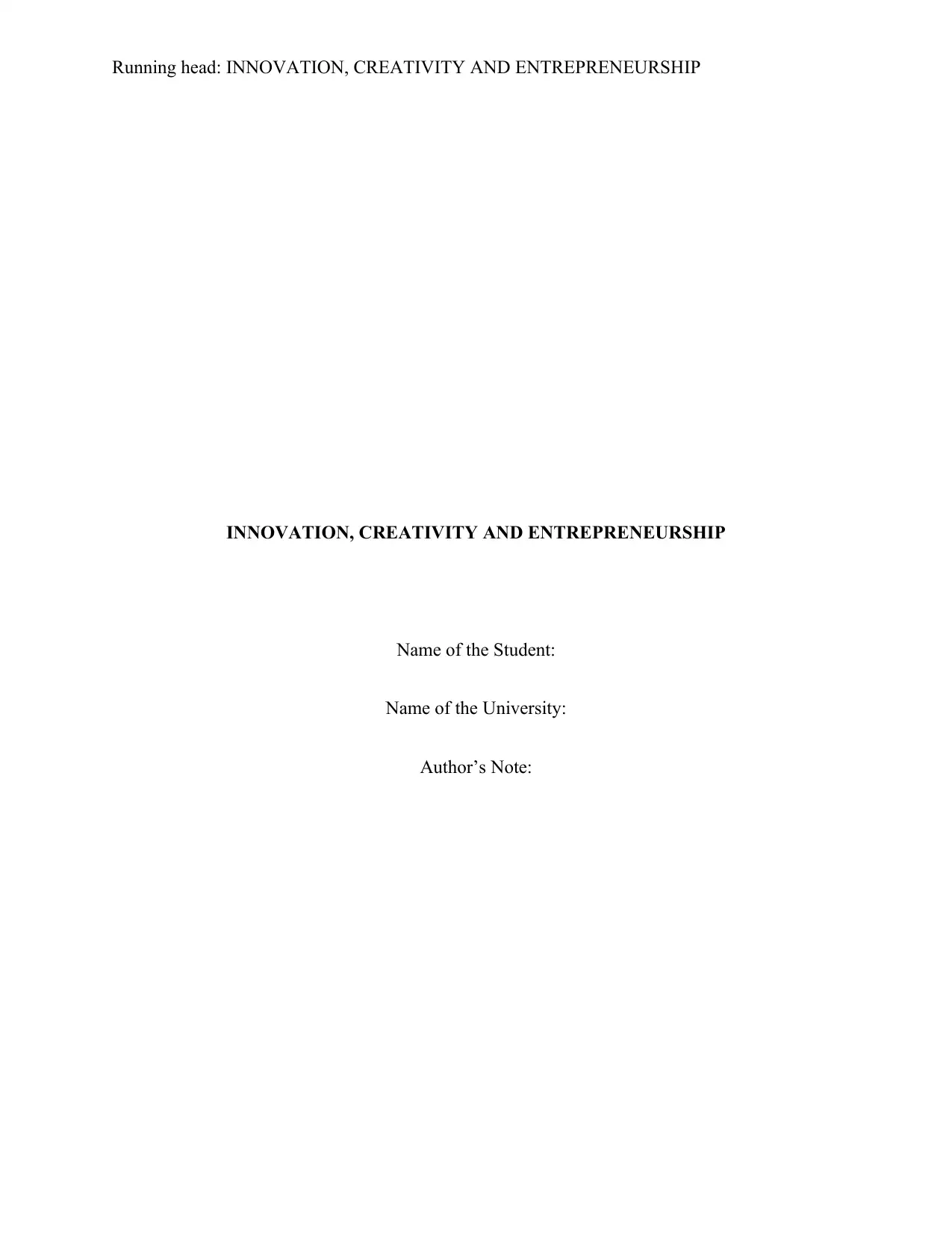
Running head: INNOVATION, CREATIVITY AND ENTREPRENEURSHIP
INNOVATION, CREATIVITY AND ENTREPRENEURSHIP
Name of the Student:
Name of the University:
Author’s Note:
INNOVATION, CREATIVITY AND ENTREPRENEURSHIP
Name of the Student:
Name of the University:
Author’s Note:
Paraphrase This Document
Need a fresh take? Get an instant paraphrase of this document with our AI Paraphraser
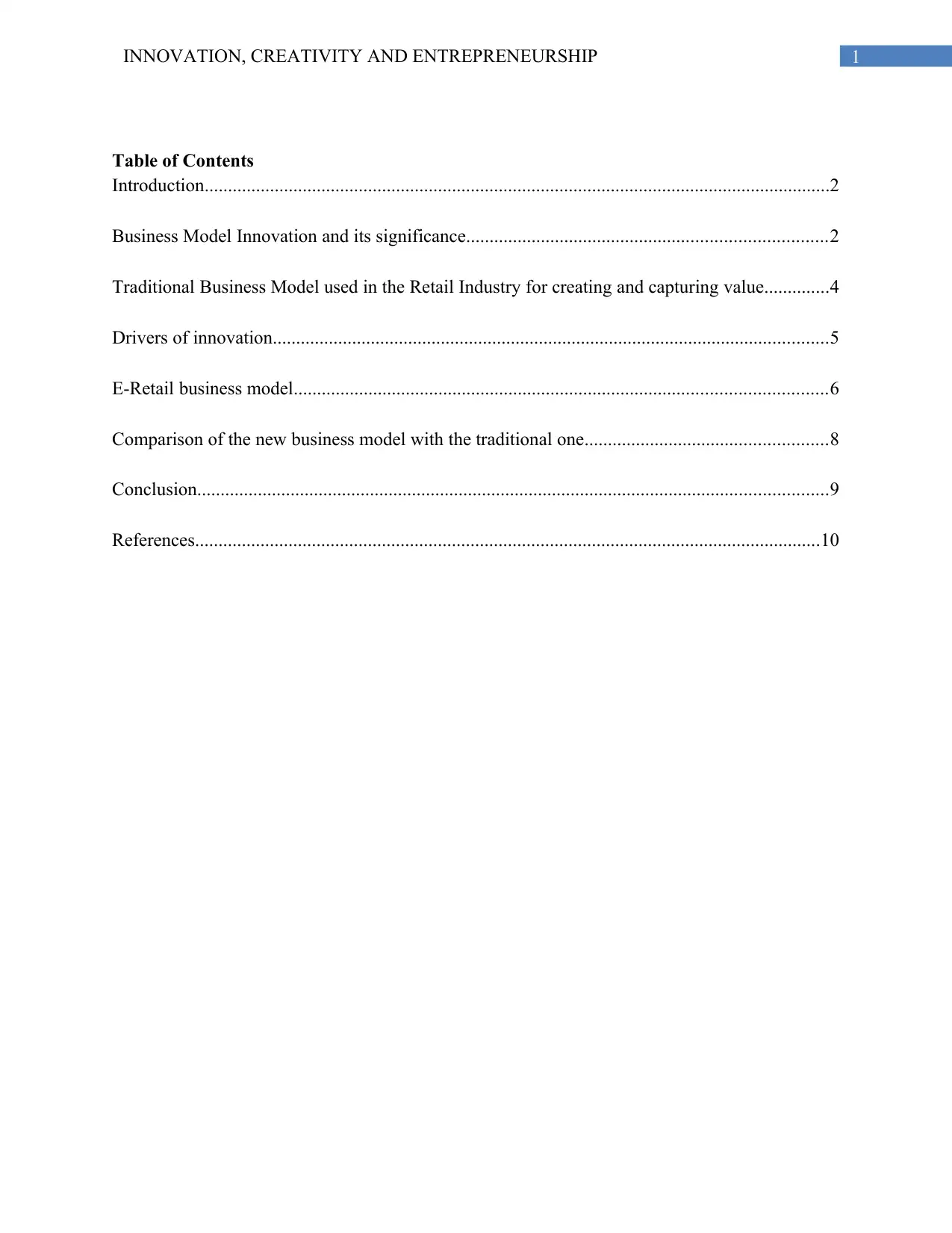
1INNOVATION, CREATIVITY AND ENTREPRENEURSHIP
Table of Contents
Introduction......................................................................................................................................2
Business Model Innovation and its significance.............................................................................2
Traditional Business Model used in the Retail Industry for creating and capturing value..............4
Drivers of innovation.......................................................................................................................5
E-Retail business model..................................................................................................................6
Comparison of the new business model with the traditional one....................................................8
Conclusion.......................................................................................................................................9
References......................................................................................................................................10
Table of Contents
Introduction......................................................................................................................................2
Business Model Innovation and its significance.............................................................................2
Traditional Business Model used in the Retail Industry for creating and capturing value..............4
Drivers of innovation.......................................................................................................................5
E-Retail business model..................................................................................................................6
Comparison of the new business model with the traditional one....................................................8
Conclusion.......................................................................................................................................9
References......................................................................................................................................10
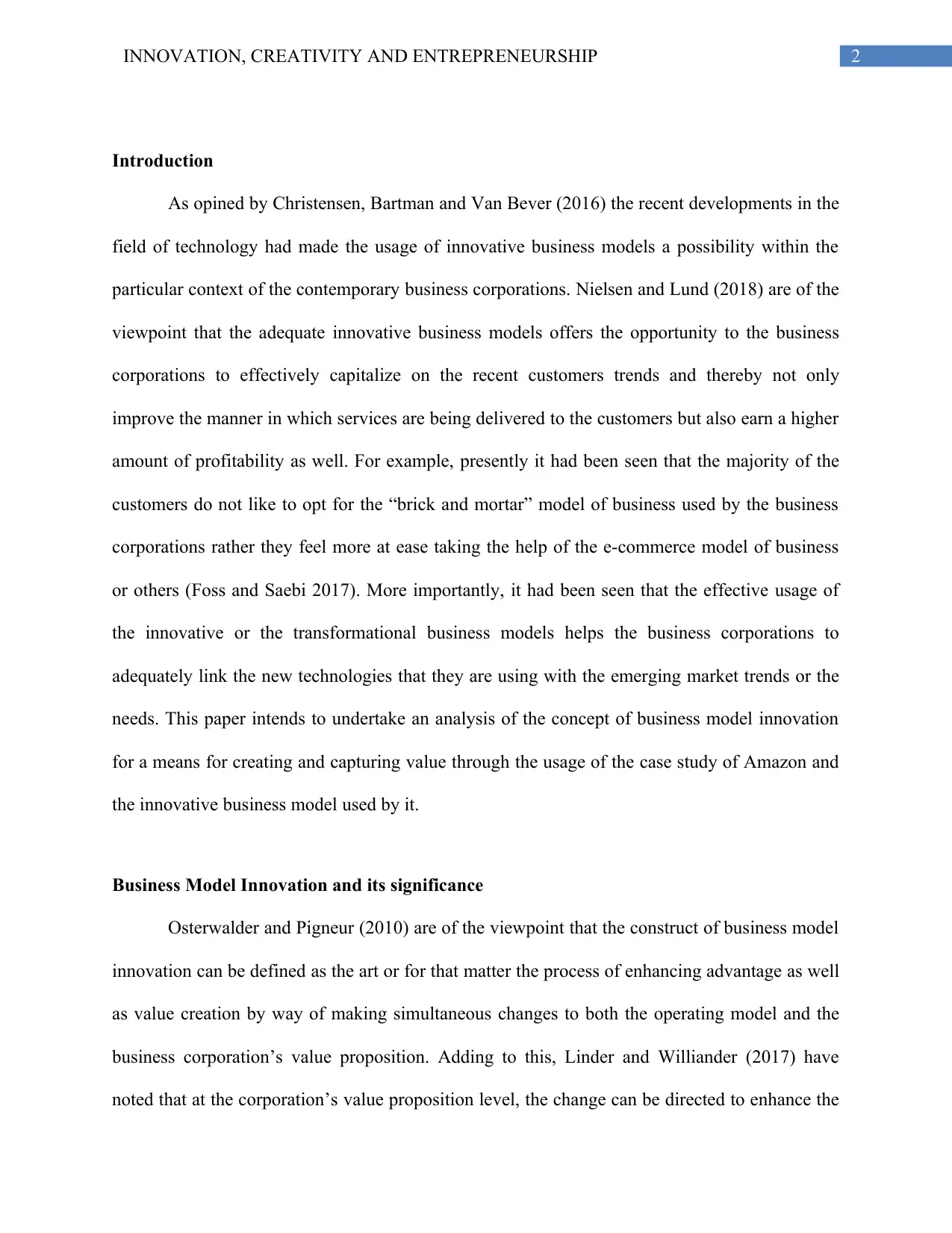
2INNOVATION, CREATIVITY AND ENTREPRENEURSHIP
Introduction
As opined by Christensen, Bartman and Van Bever (2016) the recent developments in the
field of technology had made the usage of innovative business models a possibility within the
particular context of the contemporary business corporations. Nielsen and Lund (2018) are of the
viewpoint that the adequate innovative business models offers the opportunity to the business
corporations to effectively capitalize on the recent customers trends and thereby not only
improve the manner in which services are being delivered to the customers but also earn a higher
amount of profitability as well. For example, presently it had been seen that the majority of the
customers do not like to opt for the “brick and mortar” model of business used by the business
corporations rather they feel more at ease taking the help of the e-commerce model of business
or others (Foss and Saebi 2017). More importantly, it had been seen that the effective usage of
the innovative or the transformational business models helps the business corporations to
adequately link the new technologies that they are using with the emerging market trends or the
needs. This paper intends to undertake an analysis of the concept of business model innovation
for a means for creating and capturing value through the usage of the case study of Amazon and
the innovative business model used by it.
Business Model Innovation and its significance
Osterwalder and Pigneur (2010) are of the viewpoint that the construct of business model
innovation can be defined as the art or for that matter the process of enhancing advantage as well
as value creation by way of making simultaneous changes to both the operating model and the
business corporation’s value proposition. Adding to this, Linder and Williander (2017) have
noted that at the corporation’s value proposition level, the change can be directed to enhance the
Introduction
As opined by Christensen, Bartman and Van Bever (2016) the recent developments in the
field of technology had made the usage of innovative business models a possibility within the
particular context of the contemporary business corporations. Nielsen and Lund (2018) are of the
viewpoint that the adequate innovative business models offers the opportunity to the business
corporations to effectively capitalize on the recent customers trends and thereby not only
improve the manner in which services are being delivered to the customers but also earn a higher
amount of profitability as well. For example, presently it had been seen that the majority of the
customers do not like to opt for the “brick and mortar” model of business used by the business
corporations rather they feel more at ease taking the help of the e-commerce model of business
or others (Foss and Saebi 2017). More importantly, it had been seen that the effective usage of
the innovative or the transformational business models helps the business corporations to
adequately link the new technologies that they are using with the emerging market trends or the
needs. This paper intends to undertake an analysis of the concept of business model innovation
for a means for creating and capturing value through the usage of the case study of Amazon and
the innovative business model used by it.
Business Model Innovation and its significance
Osterwalder and Pigneur (2010) are of the viewpoint that the construct of business model
innovation can be defined as the art or for that matter the process of enhancing advantage as well
as value creation by way of making simultaneous changes to both the operating model and the
business corporation’s value proposition. Adding to this, Linder and Williander (2017) have
noted that at the corporation’s value proposition level, the change can be directed to enhance the
⊘ This is a preview!⊘
Do you want full access?
Subscribe today to unlock all pages.

Trusted by 1+ million students worldwide
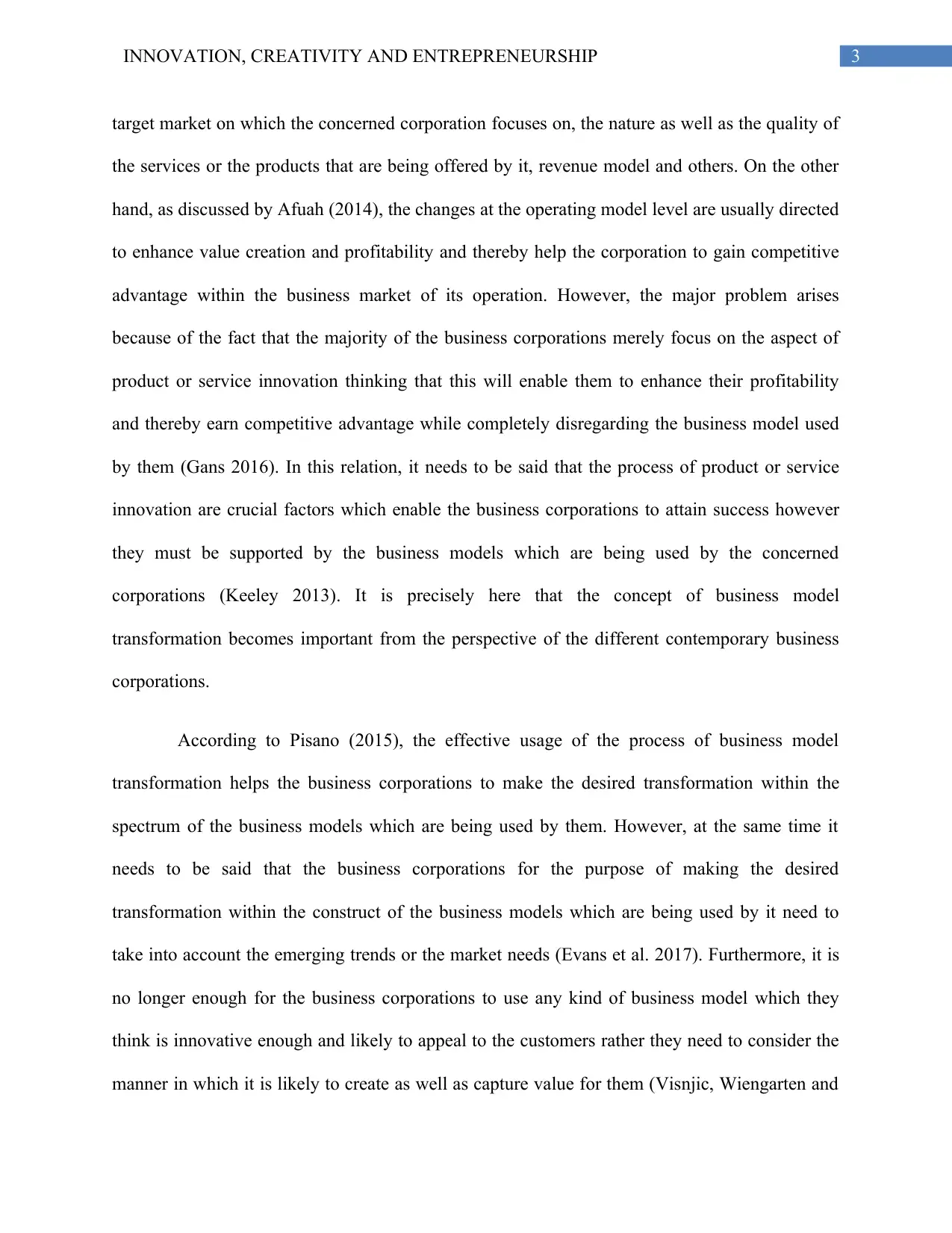
3INNOVATION, CREATIVITY AND ENTREPRENEURSHIP
target market on which the concerned corporation focuses on, the nature as well as the quality of
the services or the products that are being offered by it, revenue model and others. On the other
hand, as discussed by Afuah (2014), the changes at the operating model level are usually directed
to enhance value creation and profitability and thereby help the corporation to gain competitive
advantage within the business market of its operation. However, the major problem arises
because of the fact that the majority of the business corporations merely focus on the aspect of
product or service innovation thinking that this will enable them to enhance their profitability
and thereby earn competitive advantage while completely disregarding the business model used
by them (Gans 2016). In this relation, it needs to be said that the process of product or service
innovation are crucial factors which enable the business corporations to attain success however
they must be supported by the business models which are being used by the concerned
corporations (Keeley 2013). It is precisely here that the concept of business model
transformation becomes important from the perspective of the different contemporary business
corporations.
According to Pisano (2015), the effective usage of the process of business model
transformation helps the business corporations to make the desired transformation within the
spectrum of the business models which are being used by them. However, at the same time it
needs to be said that the business corporations for the purpose of making the desired
transformation within the construct of the business models which are being used by it need to
take into account the emerging trends or the market needs (Evans et al. 2017). Furthermore, it is
no longer enough for the business corporations to use any kind of business model which they
think is innovative enough and likely to appeal to the customers rather they need to consider the
manner in which it is likely to create as well as capture value for them (Visnjic, Wiengarten and
target market on which the concerned corporation focuses on, the nature as well as the quality of
the services or the products that are being offered by it, revenue model and others. On the other
hand, as discussed by Afuah (2014), the changes at the operating model level are usually directed
to enhance value creation and profitability and thereby help the corporation to gain competitive
advantage within the business market of its operation. However, the major problem arises
because of the fact that the majority of the business corporations merely focus on the aspect of
product or service innovation thinking that this will enable them to enhance their profitability
and thereby earn competitive advantage while completely disregarding the business model used
by them (Gans 2016). In this relation, it needs to be said that the process of product or service
innovation are crucial factors which enable the business corporations to attain success however
they must be supported by the business models which are being used by the concerned
corporations (Keeley 2013). It is precisely here that the concept of business model
transformation becomes important from the perspective of the different contemporary business
corporations.
According to Pisano (2015), the effective usage of the process of business model
transformation helps the business corporations to make the desired transformation within the
spectrum of the business models which are being used by them. However, at the same time it
needs to be said that the business corporations for the purpose of making the desired
transformation within the construct of the business models which are being used by it need to
take into account the emerging trends or the market needs (Evans et al. 2017). Furthermore, it is
no longer enough for the business corporations to use any kind of business model which they
think is innovative enough and likely to appeal to the customers rather they need to consider the
manner in which it is likely to create as well as capture value for them (Visnjic, Wiengarten and
Paraphrase This Document
Need a fresh take? Get an instant paraphrase of this document with our AI Paraphraser
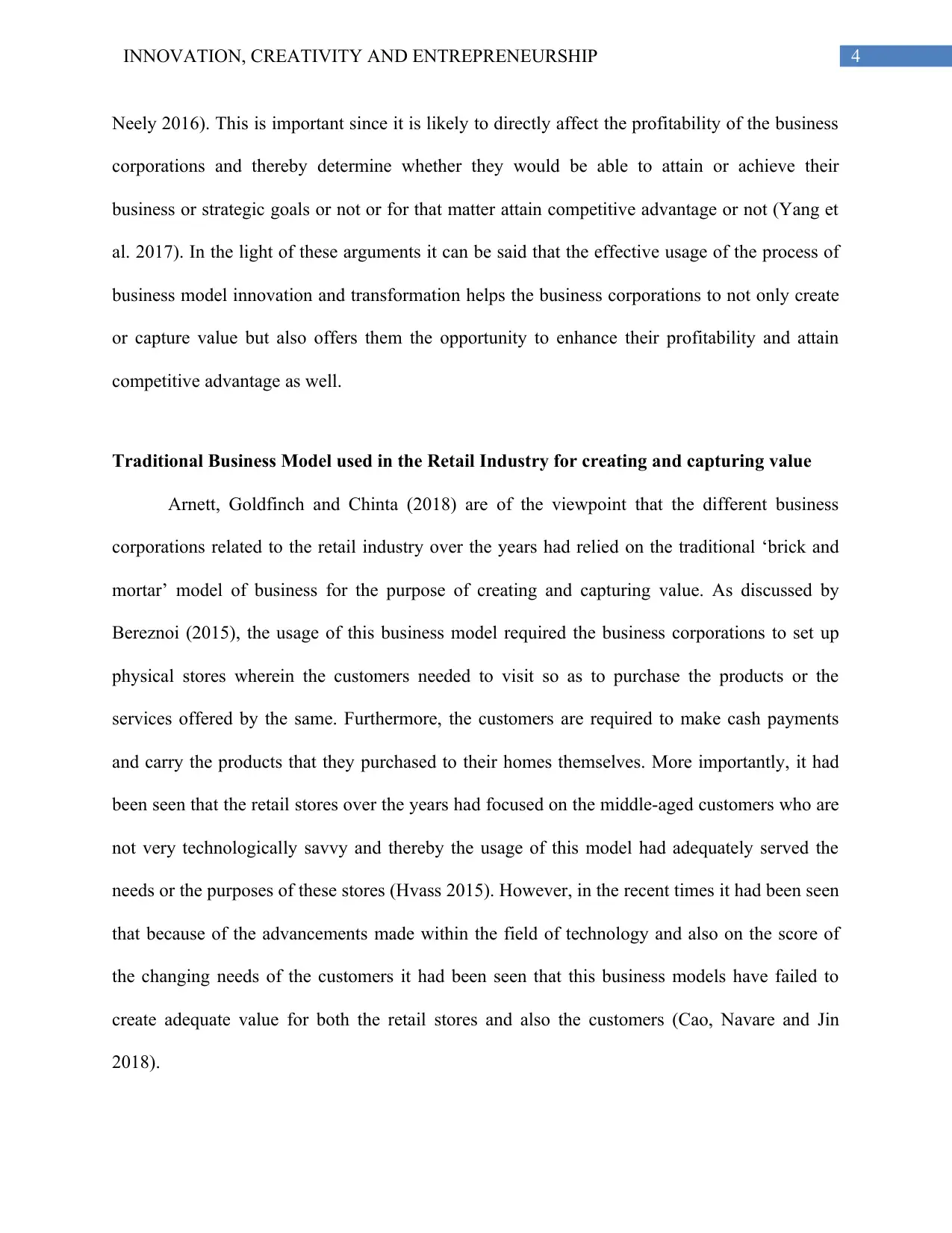
4INNOVATION, CREATIVITY AND ENTREPRENEURSHIP
Neely 2016). This is important since it is likely to directly affect the profitability of the business
corporations and thereby determine whether they would be able to attain or achieve their
business or strategic goals or not or for that matter attain competitive advantage or not (Yang et
al. 2017). In the light of these arguments it can be said that the effective usage of the process of
business model innovation and transformation helps the business corporations to not only create
or capture value but also offers them the opportunity to enhance their profitability and attain
competitive advantage as well.
Traditional Business Model used in the Retail Industry for creating and capturing value
Arnett, Goldfinch and Chinta (2018) are of the viewpoint that the different business
corporations related to the retail industry over the years had relied on the traditional ‘brick and
mortar’ model of business for the purpose of creating and capturing value. As discussed by
Bereznoi (2015), the usage of this business model required the business corporations to set up
physical stores wherein the customers needed to visit so as to purchase the products or the
services offered by the same. Furthermore, the customers are required to make cash payments
and carry the products that they purchased to their homes themselves. More importantly, it had
been seen that the retail stores over the years had focused on the middle-aged customers who are
not very technologically savvy and thereby the usage of this model had adequately served the
needs or the purposes of these stores (Hvass 2015). However, in the recent times it had been seen
that because of the advancements made within the field of technology and also on the score of
the changing needs of the customers it had been seen that this business models have failed to
create adequate value for both the retail stores and also the customers (Cao, Navare and Jin
2018).
Neely 2016). This is important since it is likely to directly affect the profitability of the business
corporations and thereby determine whether they would be able to attain or achieve their
business or strategic goals or not or for that matter attain competitive advantage or not (Yang et
al. 2017). In the light of these arguments it can be said that the effective usage of the process of
business model innovation and transformation helps the business corporations to not only create
or capture value but also offers them the opportunity to enhance their profitability and attain
competitive advantage as well.
Traditional Business Model used in the Retail Industry for creating and capturing value
Arnett, Goldfinch and Chinta (2018) are of the viewpoint that the different business
corporations related to the retail industry over the years had relied on the traditional ‘brick and
mortar’ model of business for the purpose of creating and capturing value. As discussed by
Bereznoi (2015), the usage of this business model required the business corporations to set up
physical stores wherein the customers needed to visit so as to purchase the products or the
services offered by the same. Furthermore, the customers are required to make cash payments
and carry the products that they purchased to their homes themselves. More importantly, it had
been seen that the retail stores over the years had focused on the middle-aged customers who are
not very technologically savvy and thereby the usage of this model had adequately served the
needs or the purposes of these stores (Hvass 2015). However, in the recent times it had been seen
that because of the advancements made within the field of technology and also on the score of
the changing needs of the customers it had been seen that this business models have failed to
create adequate value for both the retail stores and also the customers (Cao, Navare and Jin
2018).
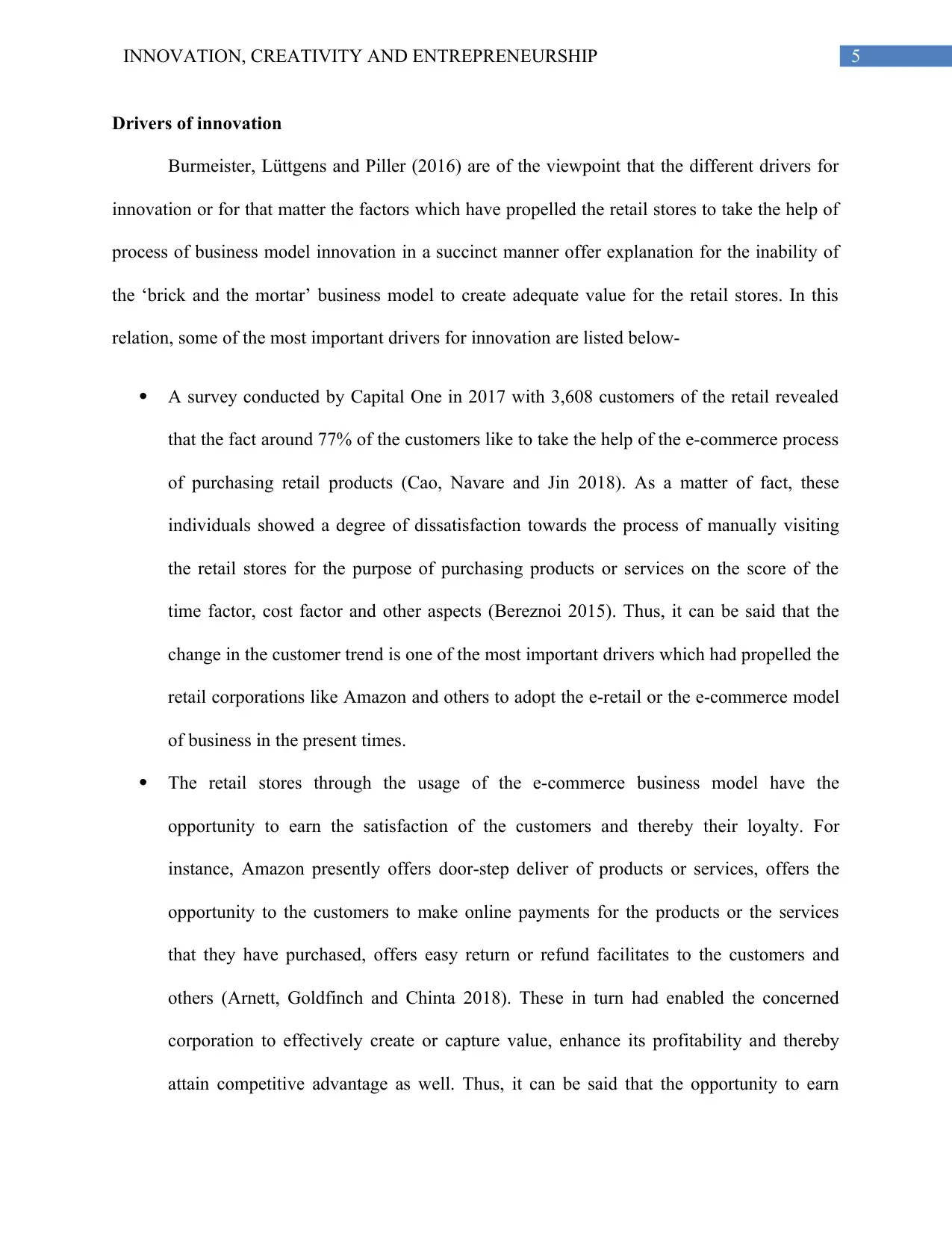
5INNOVATION, CREATIVITY AND ENTREPRENEURSHIP
Drivers of innovation
Burmeister, Lüttgens and Piller (2016) are of the viewpoint that the different drivers for
innovation or for that matter the factors which have propelled the retail stores to take the help of
process of business model innovation in a succinct manner offer explanation for the inability of
the ‘brick and the mortar’ business model to create adequate value for the retail stores. In this
relation, some of the most important drivers for innovation are listed below-
A survey conducted by Capital One in 2017 with 3,608 customers of the retail revealed
that the fact around 77% of the customers like to take the help of the e-commerce process
of purchasing retail products (Cao, Navare and Jin 2018). As a matter of fact, these
individuals showed a degree of dissatisfaction towards the process of manually visiting
the retail stores for the purpose of purchasing products or services on the score of the
time factor, cost factor and other aspects (Bereznoi 2015). Thus, it can be said that the
change in the customer trend is one of the most important drivers which had propelled the
retail corporations like Amazon and others to adopt the e-retail or the e-commerce model
of business in the present times.
The retail stores through the usage of the e-commerce business model have the
opportunity to earn the satisfaction of the customers and thereby their loyalty. For
instance, Amazon presently offers door-step deliver of products or services, offers the
opportunity to the customers to make online payments for the products or the services
that they have purchased, offers easy return or refund facilitates to the customers and
others (Arnett, Goldfinch and Chinta 2018). These in turn had enabled the concerned
corporation to effectively create or capture value, enhance its profitability and thereby
attain competitive advantage as well. Thus, it can be said that the opportunity to earn
Drivers of innovation
Burmeister, Lüttgens and Piller (2016) are of the viewpoint that the different drivers for
innovation or for that matter the factors which have propelled the retail stores to take the help of
process of business model innovation in a succinct manner offer explanation for the inability of
the ‘brick and the mortar’ business model to create adequate value for the retail stores. In this
relation, some of the most important drivers for innovation are listed below-
A survey conducted by Capital One in 2017 with 3,608 customers of the retail revealed
that the fact around 77% of the customers like to take the help of the e-commerce process
of purchasing retail products (Cao, Navare and Jin 2018). As a matter of fact, these
individuals showed a degree of dissatisfaction towards the process of manually visiting
the retail stores for the purpose of purchasing products or services on the score of the
time factor, cost factor and other aspects (Bereznoi 2015). Thus, it can be said that the
change in the customer trend is one of the most important drivers which had propelled the
retail corporations like Amazon and others to adopt the e-retail or the e-commerce model
of business in the present times.
The retail stores through the usage of the e-commerce business model have the
opportunity to earn the satisfaction of the customers and thereby their loyalty. For
instance, Amazon presently offers door-step deliver of products or services, offers the
opportunity to the customers to make online payments for the products or the services
that they have purchased, offers easy return or refund facilitates to the customers and
others (Arnett, Goldfinch and Chinta 2018). These in turn had enabled the concerned
corporation to effectively create or capture value, enhance its profitability and thereby
attain competitive advantage as well. Thus, it can be said that the opportunity to earn
⊘ This is a preview!⊘
Do you want full access?
Subscribe today to unlock all pages.

Trusted by 1+ million students worldwide
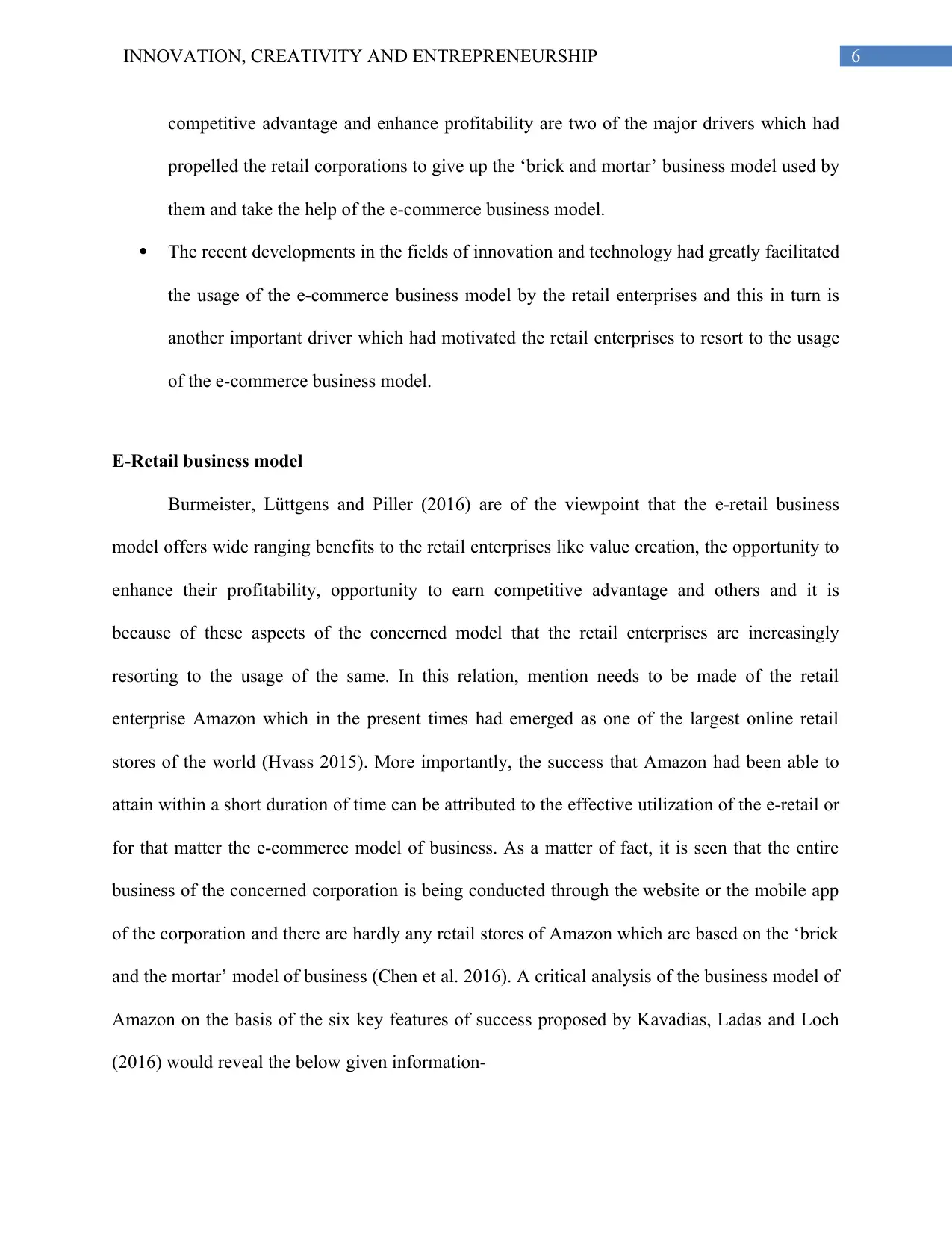
6INNOVATION, CREATIVITY AND ENTREPRENEURSHIP
competitive advantage and enhance profitability are two of the major drivers which had
propelled the retail corporations to give up the ‘brick and mortar’ business model used by
them and take the help of the e-commerce business model.
The recent developments in the fields of innovation and technology had greatly facilitated
the usage of the e-commerce business model by the retail enterprises and this in turn is
another important driver which had motivated the retail enterprises to resort to the usage
of the e-commerce business model.
E-Retail business model
Burmeister, Lüttgens and Piller (2016) are of the viewpoint that the e-retail business
model offers wide ranging benefits to the retail enterprises like value creation, the opportunity to
enhance their profitability, opportunity to earn competitive advantage and others and it is
because of these aspects of the concerned model that the retail enterprises are increasingly
resorting to the usage of the same. In this relation, mention needs to be made of the retail
enterprise Amazon which in the present times had emerged as one of the largest online retail
stores of the world (Hvass 2015). More importantly, the success that Amazon had been able to
attain within a short duration of time can be attributed to the effective utilization of the e-retail or
for that matter the e-commerce model of business. As a matter of fact, it is seen that the entire
business of the concerned corporation is being conducted through the website or the mobile app
of the corporation and there are hardly any retail stores of Amazon which are based on the ‘brick
and the mortar’ model of business (Chen et al. 2016). A critical analysis of the business model of
Amazon on the basis of the six key features of success proposed by Kavadias, Ladas and Loch
(2016) would reveal the below given information-
competitive advantage and enhance profitability are two of the major drivers which had
propelled the retail corporations to give up the ‘brick and mortar’ business model used by
them and take the help of the e-commerce business model.
The recent developments in the fields of innovation and technology had greatly facilitated
the usage of the e-commerce business model by the retail enterprises and this in turn is
another important driver which had motivated the retail enterprises to resort to the usage
of the e-commerce business model.
E-Retail business model
Burmeister, Lüttgens and Piller (2016) are of the viewpoint that the e-retail business
model offers wide ranging benefits to the retail enterprises like value creation, the opportunity to
enhance their profitability, opportunity to earn competitive advantage and others and it is
because of these aspects of the concerned model that the retail enterprises are increasingly
resorting to the usage of the same. In this relation, mention needs to be made of the retail
enterprise Amazon which in the present times had emerged as one of the largest online retail
stores of the world (Hvass 2015). More importantly, the success that Amazon had been able to
attain within a short duration of time can be attributed to the effective utilization of the e-retail or
for that matter the e-commerce model of business. As a matter of fact, it is seen that the entire
business of the concerned corporation is being conducted through the website or the mobile app
of the corporation and there are hardly any retail stores of Amazon which are based on the ‘brick
and the mortar’ model of business (Chen et al. 2016). A critical analysis of the business model of
Amazon on the basis of the six key features of success proposed by Kavadias, Ladas and Loch
(2016) would reveal the below given information-
Paraphrase This Document
Need a fresh take? Get an instant paraphrase of this document with our AI Paraphraser
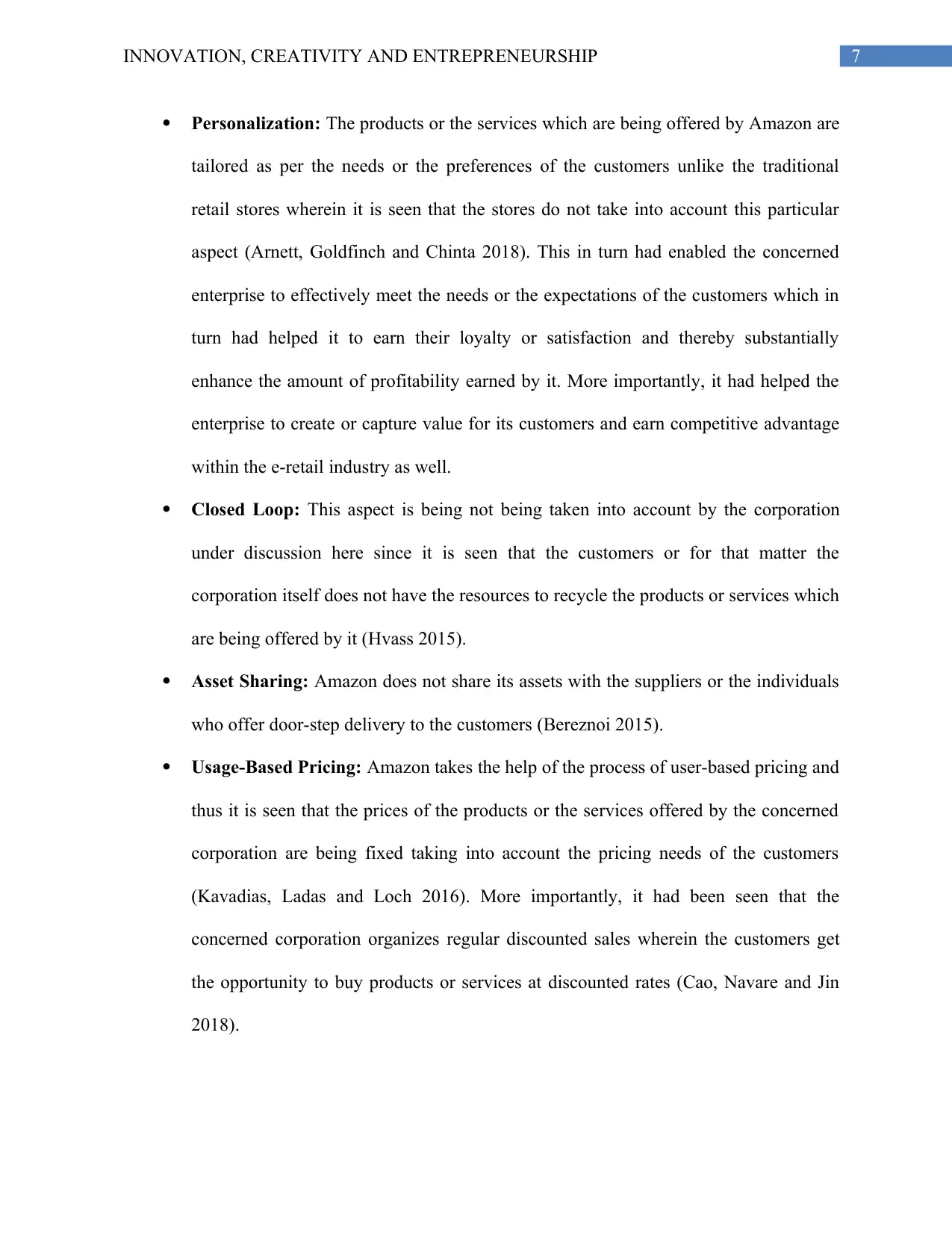
7INNOVATION, CREATIVITY AND ENTREPRENEURSHIP
Personalization: The products or the services which are being offered by Amazon are
tailored as per the needs or the preferences of the customers unlike the traditional
retail stores wherein it is seen that the stores do not take into account this particular
aspect (Arnett, Goldfinch and Chinta 2018). This in turn had enabled the concerned
enterprise to effectively meet the needs or the expectations of the customers which in
turn had helped it to earn their loyalty or satisfaction and thereby substantially
enhance the amount of profitability earned by it. More importantly, it had helped the
enterprise to create or capture value for its customers and earn competitive advantage
within the e-retail industry as well.
Closed Loop: This aspect is being not being taken into account by the corporation
under discussion here since it is seen that the customers or for that matter the
corporation itself does not have the resources to recycle the products or services which
are being offered by it (Hvass 2015).
Asset Sharing: Amazon does not share its assets with the suppliers or the individuals
who offer door-step delivery to the customers (Bereznoi 2015).
Usage-Based Pricing: Amazon takes the help of the process of user-based pricing and
thus it is seen that the prices of the products or the services offered by the concerned
corporation are being fixed taking into account the pricing needs of the customers
(Kavadias, Ladas and Loch 2016). More importantly, it had been seen that the
concerned corporation organizes regular discounted sales wherein the customers get
the opportunity to buy products or services at discounted rates (Cao, Navare and Jin
2018).
Personalization: The products or the services which are being offered by Amazon are
tailored as per the needs or the preferences of the customers unlike the traditional
retail stores wherein it is seen that the stores do not take into account this particular
aspect (Arnett, Goldfinch and Chinta 2018). This in turn had enabled the concerned
enterprise to effectively meet the needs or the expectations of the customers which in
turn had helped it to earn their loyalty or satisfaction and thereby substantially
enhance the amount of profitability earned by it. More importantly, it had helped the
enterprise to create or capture value for its customers and earn competitive advantage
within the e-retail industry as well.
Closed Loop: This aspect is being not being taken into account by the corporation
under discussion here since it is seen that the customers or for that matter the
corporation itself does not have the resources to recycle the products or services which
are being offered by it (Hvass 2015).
Asset Sharing: Amazon does not share its assets with the suppliers or the individuals
who offer door-step delivery to the customers (Bereznoi 2015).
Usage-Based Pricing: Amazon takes the help of the process of user-based pricing and
thus it is seen that the prices of the products or the services offered by the concerned
corporation are being fixed taking into account the pricing needs of the customers
(Kavadias, Ladas and Loch 2016). More importantly, it had been seen that the
concerned corporation organizes regular discounted sales wherein the customers get
the opportunity to buy products or services at discounted rates (Cao, Navare and Jin
2018).
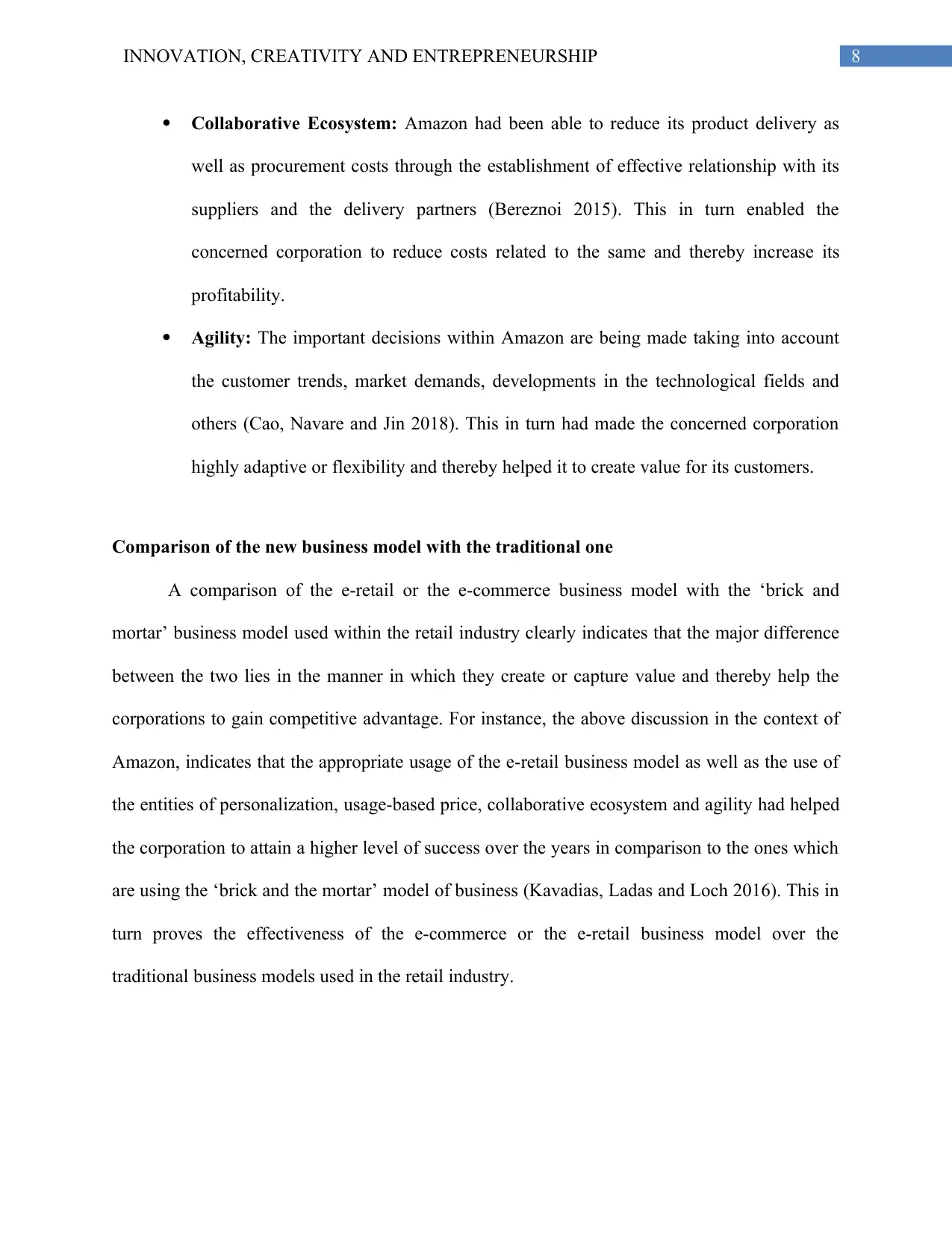
8INNOVATION, CREATIVITY AND ENTREPRENEURSHIP
Collaborative Ecosystem: Amazon had been able to reduce its product delivery as
well as procurement costs through the establishment of effective relationship with its
suppliers and the delivery partners (Bereznoi 2015). This in turn enabled the
concerned corporation to reduce costs related to the same and thereby increase its
profitability.
Agility: The important decisions within Amazon are being made taking into account
the customer trends, market demands, developments in the technological fields and
others (Cao, Navare and Jin 2018). This in turn had made the concerned corporation
highly adaptive or flexibility and thereby helped it to create value for its customers.
Comparison of the new business model with the traditional one
A comparison of the e-retail or the e-commerce business model with the ‘brick and
mortar’ business model used within the retail industry clearly indicates that the major difference
between the two lies in the manner in which they create or capture value and thereby help the
corporations to gain competitive advantage. For instance, the above discussion in the context of
Amazon, indicates that the appropriate usage of the e-retail business model as well as the use of
the entities of personalization, usage-based price, collaborative ecosystem and agility had helped
the corporation to attain a higher level of success over the years in comparison to the ones which
are using the ‘brick and the mortar’ model of business (Kavadias, Ladas and Loch 2016). This in
turn proves the effectiveness of the e-commerce or the e-retail business model over the
traditional business models used in the retail industry.
Collaborative Ecosystem: Amazon had been able to reduce its product delivery as
well as procurement costs through the establishment of effective relationship with its
suppliers and the delivery partners (Bereznoi 2015). This in turn enabled the
concerned corporation to reduce costs related to the same and thereby increase its
profitability.
Agility: The important decisions within Amazon are being made taking into account
the customer trends, market demands, developments in the technological fields and
others (Cao, Navare and Jin 2018). This in turn had made the concerned corporation
highly adaptive or flexibility and thereby helped it to create value for its customers.
Comparison of the new business model with the traditional one
A comparison of the e-retail or the e-commerce business model with the ‘brick and
mortar’ business model used within the retail industry clearly indicates that the major difference
between the two lies in the manner in which they create or capture value and thereby help the
corporations to gain competitive advantage. For instance, the above discussion in the context of
Amazon, indicates that the appropriate usage of the e-retail business model as well as the use of
the entities of personalization, usage-based price, collaborative ecosystem and agility had helped
the corporation to attain a higher level of success over the years in comparison to the ones which
are using the ‘brick and the mortar’ model of business (Kavadias, Ladas and Loch 2016). This in
turn proves the effectiveness of the e-commerce or the e-retail business model over the
traditional business models used in the retail industry.
⊘ This is a preview!⊘
Do you want full access?
Subscribe today to unlock all pages.

Trusted by 1+ million students worldwide
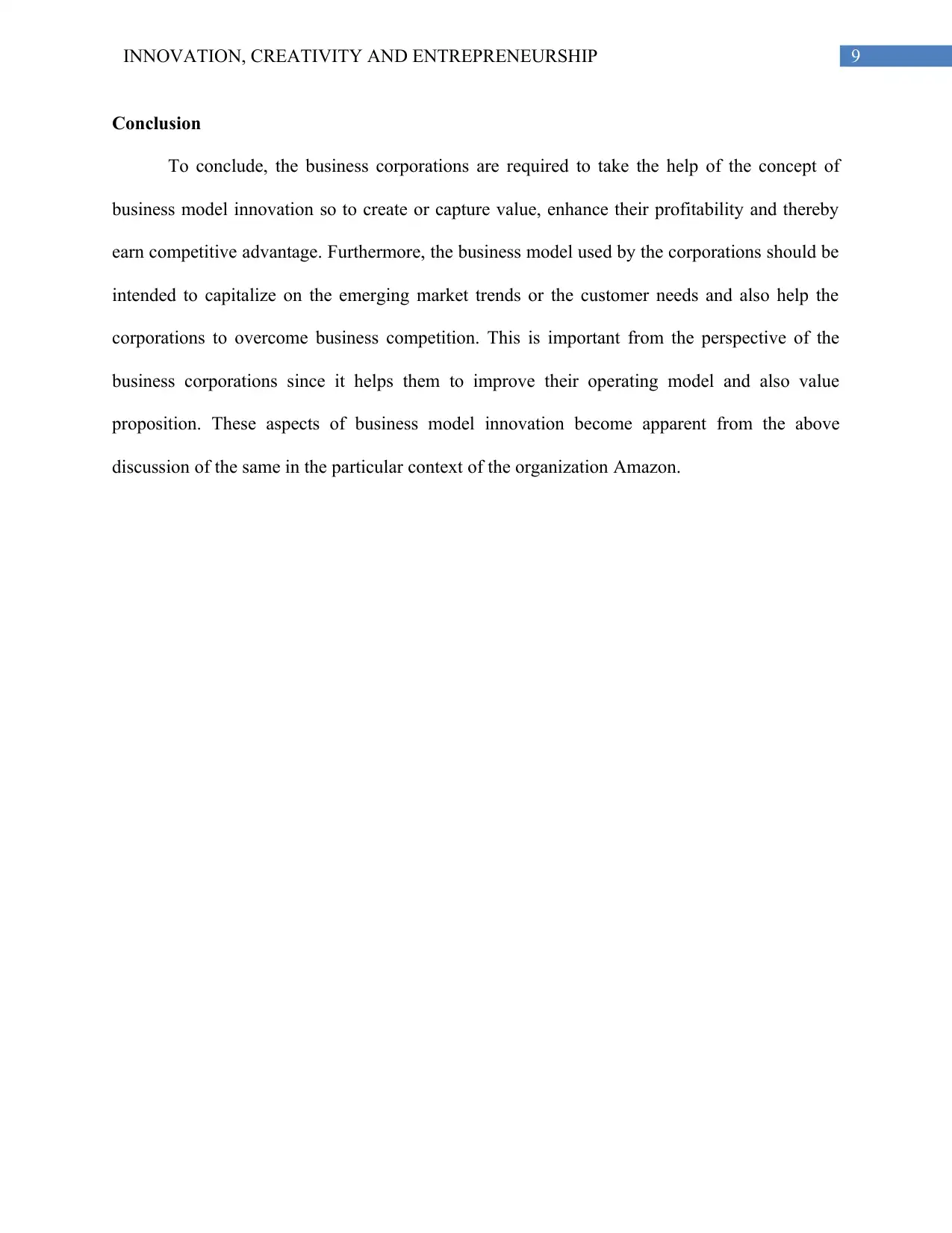
9INNOVATION, CREATIVITY AND ENTREPRENEURSHIP
Conclusion
To conclude, the business corporations are required to take the help of the concept of
business model innovation so to create or capture value, enhance their profitability and thereby
earn competitive advantage. Furthermore, the business model used by the corporations should be
intended to capitalize on the emerging market trends or the customer needs and also help the
corporations to overcome business competition. This is important from the perspective of the
business corporations since it helps them to improve their operating model and also value
proposition. These aspects of business model innovation become apparent from the above
discussion of the same in the particular context of the organization Amazon.
Conclusion
To conclude, the business corporations are required to take the help of the concept of
business model innovation so to create or capture value, enhance their profitability and thereby
earn competitive advantage. Furthermore, the business model used by the corporations should be
intended to capitalize on the emerging market trends or the customer needs and also help the
corporations to overcome business competition. This is important from the perspective of the
business corporations since it helps them to improve their operating model and also value
proposition. These aspects of business model innovation become apparent from the above
discussion of the same in the particular context of the organization Amazon.
Paraphrase This Document
Need a fresh take? Get an instant paraphrase of this document with our AI Paraphraser
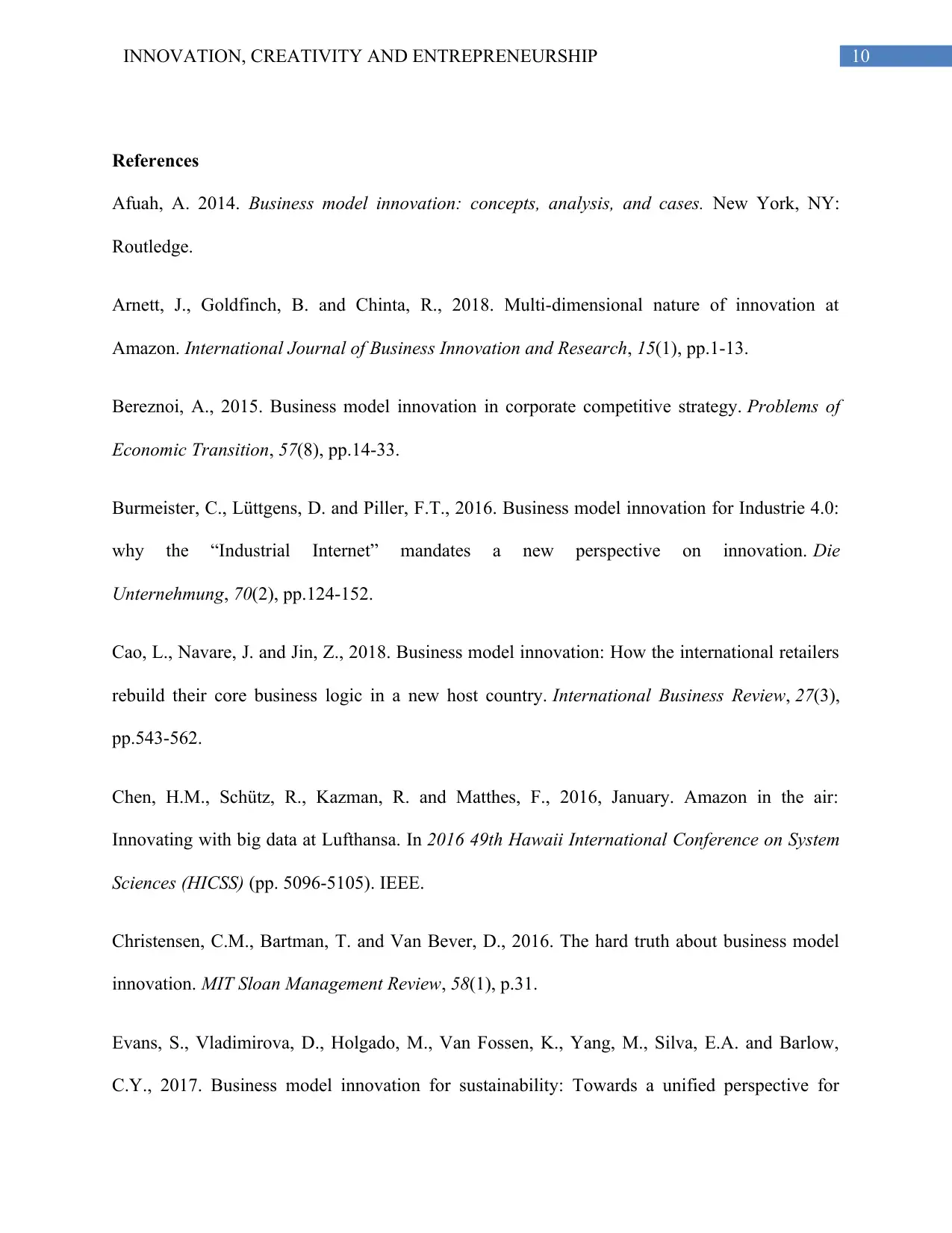
10INNOVATION, CREATIVITY AND ENTREPRENEURSHIP
References
Afuah, A. 2014. Business model innovation: concepts, analysis, and cases. New York, NY:
Routledge.
Arnett, J., Goldfinch, B. and Chinta, R., 2018. Multi-dimensional nature of innovation at
Amazon. International Journal of Business Innovation and Research, 15(1), pp.1-13.
Bereznoi, A., 2015. Business model innovation in corporate competitive strategy. Problems of
Economic Transition, 57(8), pp.14-33.
Burmeister, C., Lüttgens, D. and Piller, F.T., 2016. Business model innovation for Industrie 4.0:
why the “Industrial Internet” mandates a new perspective on innovation. Die
Unternehmung, 70(2), pp.124-152.
Cao, L., Navare, J. and Jin, Z., 2018. Business model innovation: How the international retailers
rebuild their core business logic in a new host country. International Business Review, 27(3),
pp.543-562.
Chen, H.M., Schütz, R., Kazman, R. and Matthes, F., 2016, January. Amazon in the air:
Innovating with big data at Lufthansa. In 2016 49th Hawaii International Conference on System
Sciences (HICSS) (pp. 5096-5105). IEEE.
Christensen, C.M., Bartman, T. and Van Bever, D., 2016. The hard truth about business model
innovation. MIT Sloan Management Review, 58(1), p.31.
Evans, S., Vladimirova, D., Holgado, M., Van Fossen, K., Yang, M., Silva, E.A. and Barlow,
C.Y., 2017. Business model innovation for sustainability: Towards a unified perspective for
References
Afuah, A. 2014. Business model innovation: concepts, analysis, and cases. New York, NY:
Routledge.
Arnett, J., Goldfinch, B. and Chinta, R., 2018. Multi-dimensional nature of innovation at
Amazon. International Journal of Business Innovation and Research, 15(1), pp.1-13.
Bereznoi, A., 2015. Business model innovation in corporate competitive strategy. Problems of
Economic Transition, 57(8), pp.14-33.
Burmeister, C., Lüttgens, D. and Piller, F.T., 2016. Business model innovation for Industrie 4.0:
why the “Industrial Internet” mandates a new perspective on innovation. Die
Unternehmung, 70(2), pp.124-152.
Cao, L., Navare, J. and Jin, Z., 2018. Business model innovation: How the international retailers
rebuild their core business logic in a new host country. International Business Review, 27(3),
pp.543-562.
Chen, H.M., Schütz, R., Kazman, R. and Matthes, F., 2016, January. Amazon in the air:
Innovating with big data at Lufthansa. In 2016 49th Hawaii International Conference on System
Sciences (HICSS) (pp. 5096-5105). IEEE.
Christensen, C.M., Bartman, T. and Van Bever, D., 2016. The hard truth about business model
innovation. MIT Sloan Management Review, 58(1), p.31.
Evans, S., Vladimirova, D., Holgado, M., Van Fossen, K., Yang, M., Silva, E.A. and Barlow,
C.Y., 2017. Business model innovation for sustainability: Towards a unified perspective for
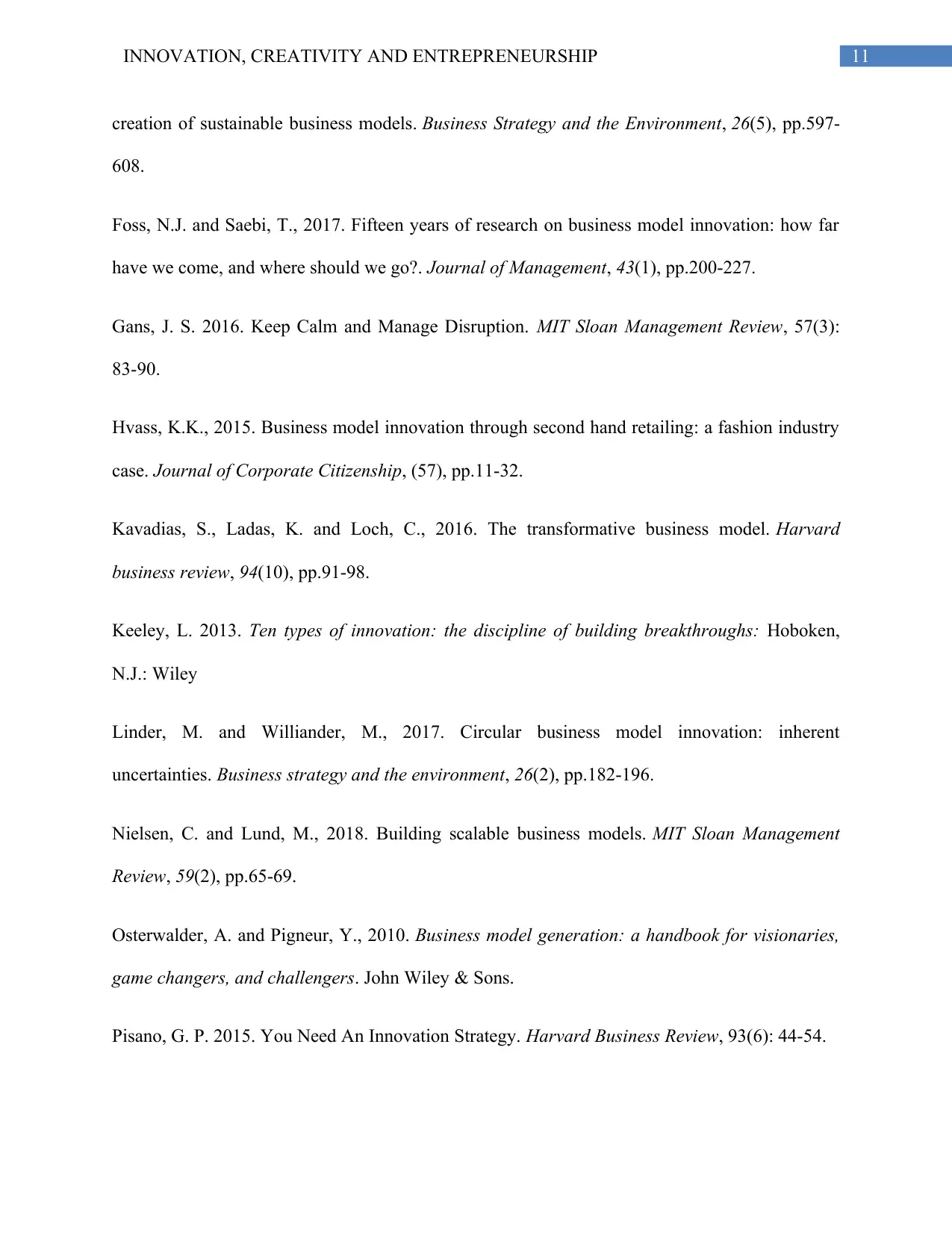
11INNOVATION, CREATIVITY AND ENTREPRENEURSHIP
creation of sustainable business models. Business Strategy and the Environment, 26(5), pp.597-
608.
Foss, N.J. and Saebi, T., 2017. Fifteen years of research on business model innovation: how far
have we come, and where should we go?. Journal of Management, 43(1), pp.200-227.
Gans, J. S. 2016. Keep Calm and Manage Disruption. MIT Sloan Management Review, 57(3):
83-90.
Hvass, K.K., 2015. Business model innovation through second hand retailing: a fashion industry
case. Journal of Corporate Citizenship, (57), pp.11-32.
Kavadias, S., Ladas, K. and Loch, C., 2016. The transformative business model. Harvard
business review, 94(10), pp.91-98.
Keeley, L. 2013. Ten types of innovation: the discipline of building breakthroughs: Hoboken,
N.J.: Wiley
Linder, M. and Williander, M., 2017. Circular business model innovation: inherent
uncertainties. Business strategy and the environment, 26(2), pp.182-196.
Nielsen, C. and Lund, M., 2018. Building scalable business models. MIT Sloan Management
Review, 59(2), pp.65-69.
Osterwalder, A. and Pigneur, Y., 2010. Business model generation: a handbook for visionaries,
game changers, and challengers. John Wiley & Sons.
Pisano, G. P. 2015. You Need An Innovation Strategy. Harvard Business Review, 93(6): 44-54.
creation of sustainable business models. Business Strategy and the Environment, 26(5), pp.597-
608.
Foss, N.J. and Saebi, T., 2017. Fifteen years of research on business model innovation: how far
have we come, and where should we go?. Journal of Management, 43(1), pp.200-227.
Gans, J. S. 2016. Keep Calm and Manage Disruption. MIT Sloan Management Review, 57(3):
83-90.
Hvass, K.K., 2015. Business model innovation through second hand retailing: a fashion industry
case. Journal of Corporate Citizenship, (57), pp.11-32.
Kavadias, S., Ladas, K. and Loch, C., 2016. The transformative business model. Harvard
business review, 94(10), pp.91-98.
Keeley, L. 2013. Ten types of innovation: the discipline of building breakthroughs: Hoboken,
N.J.: Wiley
Linder, M. and Williander, M., 2017. Circular business model innovation: inherent
uncertainties. Business strategy and the environment, 26(2), pp.182-196.
Nielsen, C. and Lund, M., 2018. Building scalable business models. MIT Sloan Management
Review, 59(2), pp.65-69.
Osterwalder, A. and Pigneur, Y., 2010. Business model generation: a handbook for visionaries,
game changers, and challengers. John Wiley & Sons.
Pisano, G. P. 2015. You Need An Innovation Strategy. Harvard Business Review, 93(6): 44-54.
⊘ This is a preview!⊘
Do you want full access?
Subscribe today to unlock all pages.

Trusted by 1+ million students worldwide
1 out of 13
Related Documents
Your All-in-One AI-Powered Toolkit for Academic Success.
+13062052269
info@desklib.com
Available 24*7 on WhatsApp / Email
![[object Object]](/_next/static/media/star-bottom.7253800d.svg)
Unlock your academic potential
Copyright © 2020–2025 A2Z Services. All Rights Reserved. Developed and managed by ZUCOL.





